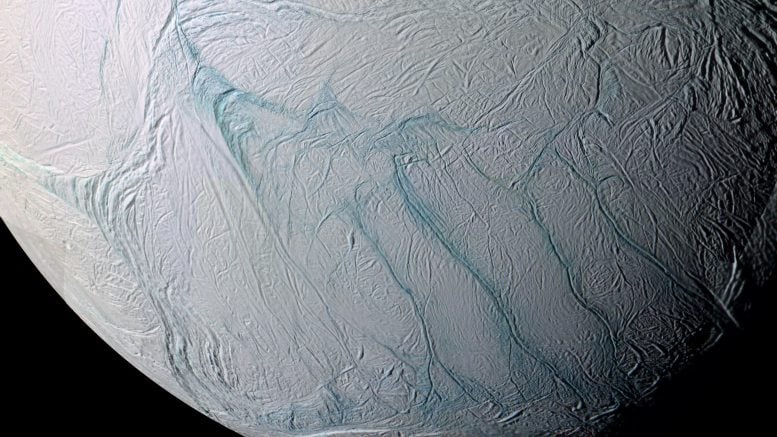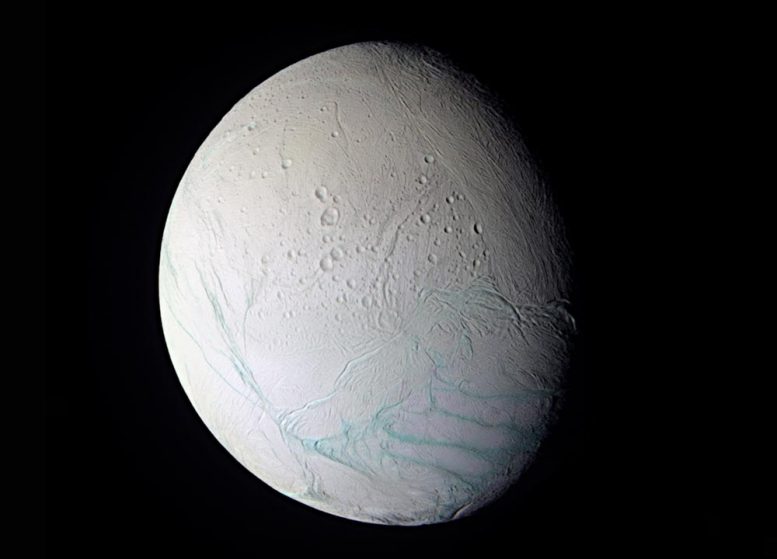
This enhanced color view of Saturn’s moon Enceladus shows the south polar terrain, where jets of material spray out form long cracks called Tiger Stripes. Credit: NASA/JPL-Caltech/Space Science Institute
Saturn’s tiny, frozen moon Enceladus is a strange place. Just 300 miles across, the moon is thought to have an outer shell of ice covering a global ocean 20 miles deep, encasing a rocky core. Slashed across Enceladus’ south pole are four straight, parallel fissures or “tiger stripes” from which water erupts. These fissures aren’t quite like anything else in the Solar System.
“We want to know why the eruptions are located at the south pole as opposed to some other place on Enceladus, how these eruptions can be sustained over long periods of time and finally why these eruptions are emanating from regularly spaced cracks,” said Max Rudolph, assistant professor of earth and planetary sciences at the University of California, Davis.

Slashed across the south pole of Saturn’s moon Enceladus are four straight, parallel fissures or “tiger stripes” from which water erupts. These fissures aren’t quite like anything else in the Solar System. Now researchers at UC Davis, the Carnegie Institution and UC Berkeley have an explanation. Using numerical modeling, they explain how tidal heating causes the fissures and their spacing. This false color image from the Cassini mission shows the fissures in blue. Credit: NASA/JPL/Space Science Institute
Rudolph and colleagues Douglas Hemingway of the Carnegie Institution for Science, Washington D.C. and Michael Manga of UC Berkeley now think they have a good explanation for Enceladus’ erupting stripes. They used numerical modeling to understand the forces acting on Enceladus’ icy shell.
Saturn’s gravity exerts tidal forces on Enceladus, which cause heating and cooling of the tiny world. Those forces are strongest at the poles. As liquid water solidifies into ice under the outer ice shell, it expands in volume, putting pressure on the ice until it cracks.
Enceladus’ surface temperature is about negative 200 degrees Celsius, so if a crack formed in the ice, you would expect it to freeze shut pretty quickly. Yet the south polar fissures remain open, and in fact reach all the way to the liquid ocean below.
That’s because liquid water within the fissure is sloshed around by tidal forces produced by Saturn’s gravity, releasing energy as heat, Rudolph said. That stops the crack from freezing shut.
The release of pressure from the fissures stops new cracks from forming elsewhere on the moon, such as at the north pole. But at the same time, water vented from the crack falls back as ice, building up the edges of the fissure and weighing it down a bit. That causes the ice sheet to flex, the researchers calculate, just enough to set off a parallel crack about 20 miles away.
“Our model explains the regular spacing of the cracks,” Rudolph said.
###
Reference: “Cascading parallel fractures on Enceladus” by Douglas J. Hemingway, Maxwell L. Rudolph and Michael Manga, 9 December 2019, Nature Astronomy.
DOI: 10.1038/s41550-019-0958-x
The work was based on data collected by the NASA/ESA Cassini mission to Saturn. Funding was also provided by NASA and the National Science Foundation.
Science - Latest - Google News
December 09, 2019 at 11:57PM
https://ift.tt/2sgTv3x
Strange Erupting ‘Tiger Stripes’ on Saturn’s Icy Moon Enceladus Finally Explained - SciTechDaily
Science - Latest - Google News
https://ift.tt/2Kb7H4e
Shoes Man Tutorial
Pos News Update
Meme Update
Korean Entertainment News
Japan News Update
Bagikan Berita Ini














0 Response to "Strange Erupting ‘Tiger Stripes’ on Saturn’s Icy Moon Enceladus Finally Explained - SciTechDaily"
Post a Comment